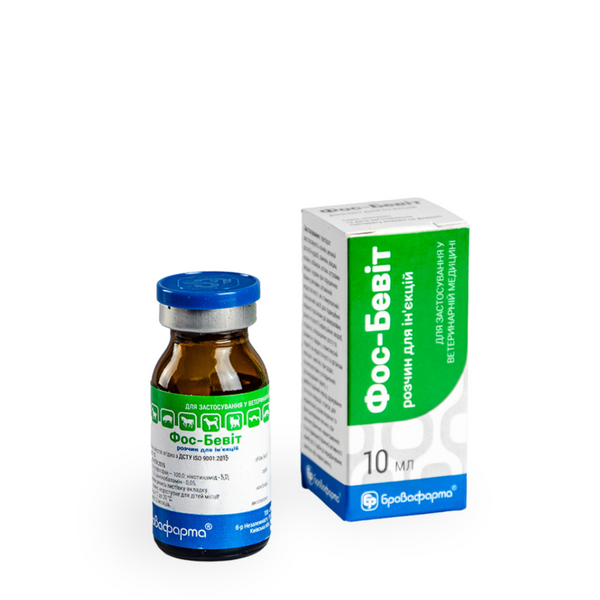|
Quantity
|
Out of stock
|
||
|
|
|||
A complex preparation based on butaphosphane and three B vitamins (nicotinamide, folic acid, cyanocobalamin).
A transparent yellow solution.
Animals for which the drug can be used:
horses, cows, goats, sheep, pigs, dogs, cats, fur animals, chickens
• Has tonic properties;
• Normalizes metabolic and regenerative processes;
• Stimulates protein, carbohydrate and fat metabolism;
• Increases the body's resistance to adverse environmental factors, infections and toxins;
• Promotes the growth and development of animals.
The first and constant assistant to the doctor when it is necessary to achieve a quick therapeutic effect in complex therapy for any animal diseases!
storage
1 ml of the drug contains active substances (mg):
- butaphosphane - 100.0;
- nicotinamide - 5.0;
- folic acid - 1.5;
- cyanocobalamin - 0.05.
Excipients: methylparaben, pyrogen-free water.
Pharmacological properties
Phos-Bevit is a complex preparation based on butaphosphane and three B vitamins. It has tonic properties, normalizes metabolic and regenerative processes, provides a stimulating effect on protein, carbohydrate and fat metabolism, increases the body's resistance to adverse external factors, promotes the growth and development of animals and birds
Butaphosphan is an organic phosphorus compound that affects a number of assimilation processes in the body of animals, stimulates protein synthesis, accelerates the growth and development of animals, normalizes the functioning of the liver, increases non-specific resistance of the body, promotes the formation of bone tissue. In stressful situations, butaphosphan normalizes the level of the stress hormone - hydrocortisone, thanks to which the utilization of glucose in the blood improves and the body's energy resources are preserved. Butaphosphan does not accumulate in the body and does not cause side effects typical of stimulants and inorganic phosphorus.
Nicotinamide stimulates the production of nicotinamide dinucleotide phosphate (NADP) and nicotinamide dinucleotide (NAD), which regulate the course of most redox reactions, ensuring the normalization of many types of metabolism (including energy). It is present in the metabolism of fats, proteins, amino acids, purines, tissue respiration, glycogenolysis. Nicotinamide helps the body resist infectious diseases, has detoxification properties, is quickly distributed in tissues and passes through the placental barrier. It is metabolized in the liver with the formation of N-methylnicotinamide, methylpyridone carboxamides, glucuronide and a complex with glycine. Excreted through the kidneys with urine.
Folic acid is one of the enzymes of amino acid synthesis, present in choline metabolism. The need for this vitamin increases with an increase in the content of vitamin B 12. In the body, folic acid is reduced to tetrahydrofolic acid, a coenzyme that is present in many metabolic processes. Folic acid contributes to the synthesis of amino acids, nucleic acids, pyrimidines, and purines. Together with cyanocobalamin, it stimulates the process of hematopoiesis, partly erythropoiesis. Necessary for the normal development of blood cells, in particular the formation and maturation of megaloblasts.
Cyanocobalamin as a metabolite activates the metabolism of carbohydrates, proteins and lipids, promotes the synthesis of labile groups in the formation of choline, methionine, nucleic acids, creatine, and the accumulation of compounds with sulfhydryl groups in erythrocytes. As a growth factor, it stimulates bone marrow function necessary for normoblastic erythropoiesis. Cyanocobalamin normalizes the functioning of the liver and nervous system, activates the blood clotting system, in high doses causes an increase in thromboplastic activity and prothrombin activity. With folic acid is necessary for the formation of red blood cells in the bone marrow. In the body, it binds to proteins by 90%. Excreted by kidneys and bile. Penetrates through the placental barrier.
Application
The drug is used in horses, cattle, pigs, sheep, goats, dogs, cats, fur animals and chickens for metabolic disorders, vitamin deficiency, as a stimulating and tonic agent for increasing the body's resistance to diseases of various etiologies (infectious diseases, improving growth and animal development, in complex therapy for calcium and magnesium deficiency in the body, during childbirth, postpartum complications (postpartum paresis), during the rehabilitation period of recovery and after operations, stress, to normalize hematopoiesis and liver functioning, during significant physical exertion and during increased physical activity horses (for 2-3 days of expected competitions or loads).
Dosage
It is used once for 4-5 days intramuscularly, subcutaneously or intravenously (slowly) in single doses (ml per 10 kg of body weight):
horse, cattle - 0.1-0.3;
foals, calves - 0.5-1.0;
pigs - 0.2-0.5;
piglets - 0.5-1.5;
sheep, goats - 0.5-1.0;
lambs, kid goats - 0.5-1.5;
dogs, cats and fur animals - 0.5-2.0.
Bird - by drinking for 4-5 days in doses (ml per 1 liter of drinking water):
Chickens
chicks, broilers - 2.0-3.0;
chickens, young - 1.0-1.5.
In critical cases and when animals are severely weakened, the drug is used in a half dose.
If necessary, repeat the course of treatment in the same doses after 8-15 days.
Contraindication
There are no data.
Reservation
Do not inject more than 10 ml of the drug in one place.
Release form
Solution in orange glass or polypropylene vials, closed with rubber stoppers under an aluminum break-in of 10, 20, 50, 100 and 200 ml.
Storage
In a dry, dark place in the manufacturer's packaging at temperatures from 4 to 25 °C.
The shelf life is 3 years.
































